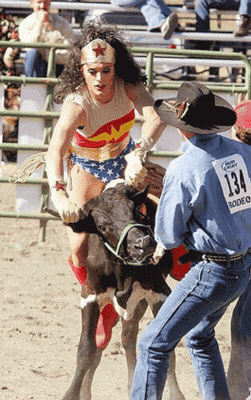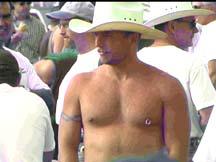 Clad in a sequined blue cocktail dress and feathered yellow headgear, Doug Graff describes his strategy for winning rodeo events.
Clad in a sequined blue cocktail dress and feathered yellow headgear, Doug Graff describes his strategy for winning rodeo events."It takes a lot of practice," he says. "You have to work as a team."
This is gay rodeo, and Graff and his partner have just won Sunday's goat-dressing event, in which two people race against the clock to catch a goat and fit a pair of underwear over its hind legs.
Graff, a.k.a. Miss Winnie Bago, has been competing in gay rodeos for four years. At the 14th annual "Best Buck in the Bay" rodeo this weekend at La Honda's Driscoll Ranches, more than 80 male and female pros and amateurs competed in 13 standard rodeo events, including bull riding, barrel-racing and calf-roping, as well as a few less-traditional ones. A quarter of the competitors come from as far as Calgary, Canada.
They do it for the cashprizes (up to $2,000 an event), the glory, and the chance to assert their identities in a sport known for its brand of Gary Cooper-style cowboys: the straight, strong and silent type.
They ride horses, don't they?
Gay rodeo was born in Reno in 1976, when Phil Ragsdale, known as the Emperor I of Reno, organized a gay rodeo event to benefit a local charity. By 1985 Colorado, Texas and California all had their own gay rodeos. The International Gay Rodeo Association was formed, and today it hosts more than 20 rodeo competitions across the United States and Canada.
Dale Greene remembers attending one of the first gay rodeos in Reno in 1978 at the tender age of 22. He was plucked from the stands and made to ride a wild calf. A photographer captured the moment, and he ended up on the cover of The Advocate magazine.
Greene hasn't entered any other competitions since, but he believes the sport has come a long way.
"This looks like any other rodeo," he said, gesturing to the ring. "When I was growing up, all the gay stuff was very gay."
A look around the grounds reveals "gay Western" culture at its finest. Next to the rodeo ring, vendors sell beer, belt buckles, and cowboy hats. Several yards away, cowboys take turns singing country karaoke.
Drag queens parade in front of the stands, primping for the "wild drag race," in which they must climb onto a bucking steer with the help of a cowboy and cowgirl. After the rodeo, dances and pool parties last far into the night.
Shattering stereotypes
There is no doubt that after 30 years, gay rodeo has tracked inroads into the mainstream. The entire IGRA circuit is sponsored by Bud Lite; its posters blanket the ring. In addition, each event is sponsored by a local business or individual — from San Mateo County Supervisor Rich Gordon to San Francisco Toyota.
 Eric Hanson — Mr. International Gay Rodeo 2004 — said the men and women who compete do more than bring the sport into mainstream America. They also shatter stereotypes about cowboy culture.
Eric Hanson — Mr. International Gay Rodeo 2004 — said the men and women who compete do more than bring the sport into mainstream America. They also shatter stereotypes about cowboy culture."In the gay community, there's a perception that this is a sport associated with a redneck attitude," said Hanson. "But the truth is, a lot of us grew up on farms in rural areas, riding horses."
Hanson said there was no way of ensuring that all competitors are gay, but all are required to join the IGRA.
Kari Majewski came from nearby San Gregorio to watch the rodeo. She said she enjoyed the horsemanship.
"It's like any other rodeo, except that guys are holding hands and girls are holding hands," she said. "The spirit of it is so positive."
from Inside Bay Area
No comments:
Post a Comment